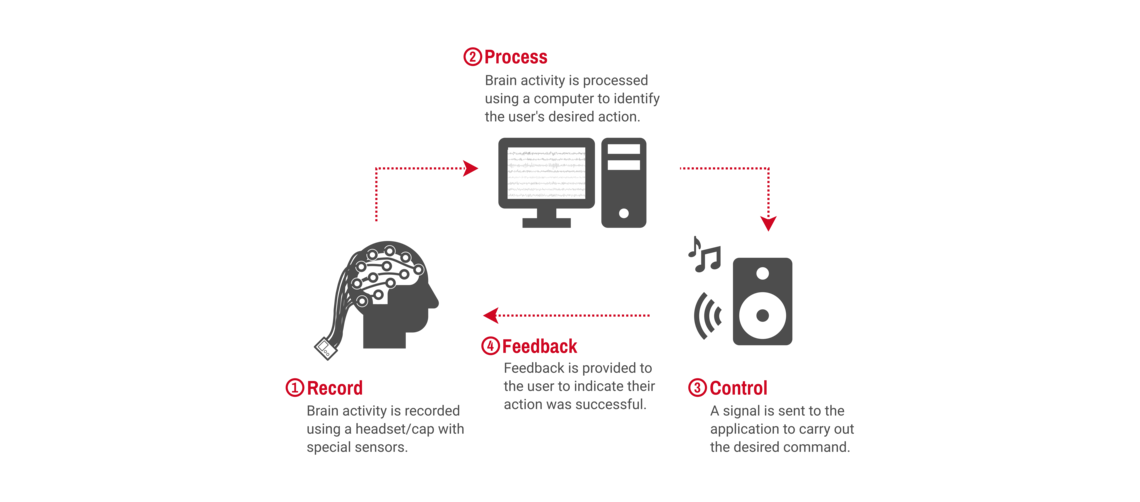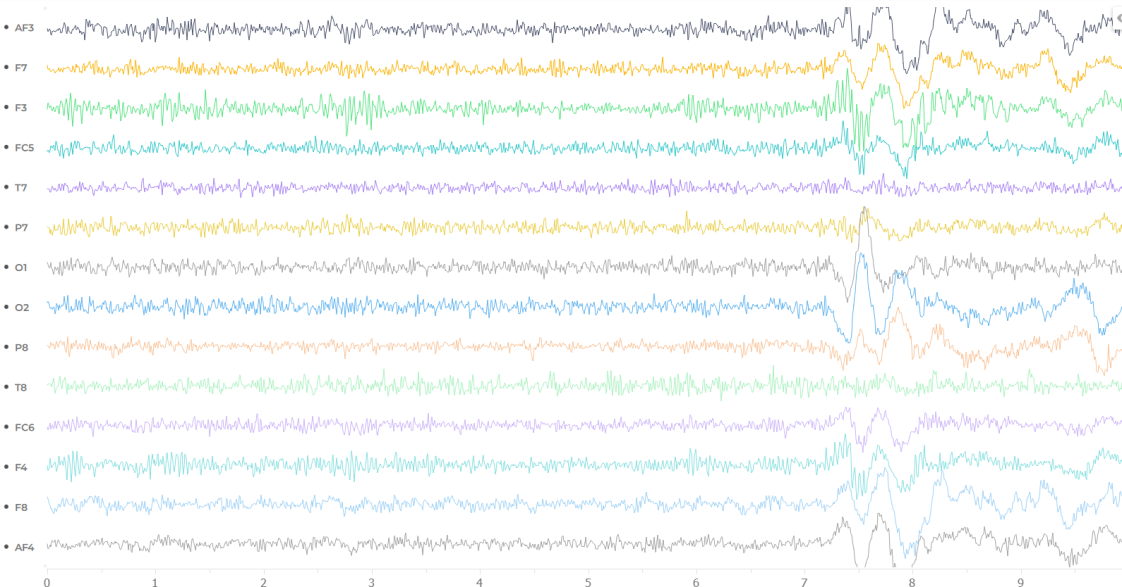
What is a Brain Computer Interface?
An Introduction to Brain Computer Interfaces
What is a Brain Computer Interface? How does it work?
A brain computer interface (BCI) is a system that determines functional intent - the desire to change, move, control, or interact with something in your environment - directly from your brain activity. In other words, BCIs allow you to control an application or a device using only your mind.
Normally, when we want to control or interact with a device in our environment (e.g. a lamp), we first decide what we want to do (turn on the lamp), then we coordinate and use the muscles in our arms, legs, hands, feet, etc., to execute that action (reach out with your finger and press the lamp's on/off switch) and then finally the device responds to that action (the lamp turns on). BCIs bypass that middle step of coordinating and using your muscles to execute the desired action, instead using a computer to identify the intended action and then controlling the application/device directly. Because of this, BCIs are being researched as a promising access technology for people with severe physical disabilities who have limited reliable control over their muscles and bodies.

Using a BCI skips over the need to have voluntary control of your muscles to interact with devices around you. The computer replaces the execution of a physical movement, instead translating your desired action and controlling the device directly.
A brain computer interface has three main parts:
- A device to measure brain activity. This is usually in the form of a headset, cap or headband that has specialized sensors embedded in it to detect and record signals coming from the brain.
- A computer to process and analyze the recorded brain activity. The BCI software will try to interpret the user's desired action from the incoming brain activity, using specialized processing methods and algorithms.
- An application/device to control. Once the computer has 'determined' what the user wants to do, it will send a signal to the application/device to carry out that command (e.g. from our previous example, turning on a lamp).
Another important part of a BCI is feedback: the system must somehow let the user know what decision or intended action the computer was able to interpret. In our previous example, the lamp successfully turning on indicates to the user that the BCI successfully identified the action the user wanted. Providing feedback helps the user adapt to the BCI system, learning how they can control and adjust their brain activity, just as we can learn to coordinate and control our muscles and bodies.

The steps of a BCI: First brain activity is recorded, then processed to determine the user's intent, then a command signal is sent to the application that is to be controlled, and finally, feedback lets the user know if their action was successful.
What exactly do you mean by 'brain activity'?
Your brain is made of up millions of cells called neurons. These neurons work together in large networks to coordinate and control processes in your body, from understanding what you see, hear, smell, taste, and feel, to executing movements, to regulating your breathing, heart rate, and metabolism.
Neurons communicate using electrochemical signals. When a neuron is activated, it generates an electrical signal that it can then transfer to the next neuron in the network, which will transfer it to the next, and so on. In this way, information can rapidly travel throughout the brain, connecting different areas that are responsible for different processes and body parts.
A single neuron on its own doesn't generate much electrical activity, but the collective activity of neurons within these networks produce enough electrical activity to be detected outside of the head. We can measure this electrical activity by placing special sensors called electrodes onto the head. We often put many electrodes on a cap, headset or headband in order to record the electrical activity coming from different regions of the brain. This method of measuring the brain's electrical activity externally is called electroencephalography, or EEG. Many BCI systems use EEG to record brain activity, although this is not the only method.

An example of an EEG headset to measure electrical brain activity. This is the Emotiv Epoc X, which is an adjustable headset that has fourteen sensors (electrodes) to record and monitor electrical brain activity.
https://www.emotiv.com/epoc-x/

A graph of EEG (electrical brain) activity for 14 different electrode locations around the head.
So you don't need surgery to use a BCI?
You may have heard of implantable, or invasive BCIs - these systems involve surgically implanting sensors directly onto the surface of the brain. These systems also measure the electrical activity of neurons, but because the electrical activity doesn't have to travel through bone, skin and hair to get to the sensor, the recorded activity is much stronger. Invasive BCIs are being studied because these stronger signals could potentially allow us to develop more accurate or complex BCI systems than those that record signals from outside of the scalp, like EEG-based BCIs.
On the other hand, non-invasive BCIs, including those that use EEG, do not require surgery. They are perfectly safe and do not cause any pain (with the exception of mild discomfort for those with very sensitive scalps). Our program focuses on non-invasive EEG-based BCI systems.
Does this mean you can read my thoughts?
No, a BCI cannot read your thoughts. Even with implantable, invasive BCI systems (the ones that can record stronger electrical signals since they are placed closer to the brain), the technology is still very, very far from being able to "read" anyone's thoughts. Instead, what BCIs look for are patterns that occur in brain activity in response to certain external events or stimuli, or that are generated during certain cognitive processes. These patterns are typically neurophysiological phenomena that have been well documented and studied by neuroscientists and doctors. For example, if you stare at a flashing light, your brain activity will start to synchronize with the rate of that flashing light, and this synchronizing pattern can be detected by the BCI. There are several types of BCIs paradigms, which are all based on their own neurophysiological pattern. We have more information coming soon about some of the most common BCI paradigms and these patterns that they employ!
Who can use a BCI?
Some of the first applications of BCIs were to help people with locked-in syndrome (that is, people who have lost all ability to voluntary control their muscles and therefore cannot move, speak or even blink or move their eyes) to communicate. Locked-in syndrome can be the result of long-term neurodegenerative disease like ALS (amyotrophic lateral sclerosis). Individuals that are locked-in physically are generally still cognitively aware - their thoughts and feelings are unaffected, they just have no way of sharing them with the world.
While the original BCI systems were designed for locked-in individuals, their value for individuals with other degrees of physical impairment were quickly recognized. Research began to see how BCIs could be used and implemented to replace, restore or supplement muscle control for people with a wide range of physical disabilities. BCI research in this area has rapidly expanded, and BCIs are now being explored as a means to drive power wheelchairs, as a way to operate prosthetic limbs, as a way to administrate neuro-regenerative therapies like functional electrical stimulation (FES), as access technologies to things like communication devices, personal computers, tablets, and environmental controls to name a few applications.
BCIs are also not limited to people with physical disabilities. With the expansion of BCI research, it also translated to the typically developed population. BCIs are now being developed for applications like assessing fatigue for attention-demanding jobs like air traffic controllers or truck drivers, for creating new immersive experiences for video games and virtual reality, and for assessing users emotions and reactions in 'neuromarketing' strategies. There are even some devices already available commercially, such as 'brain-sensing' headbands that monitor your relaxation and focus levels as you meditate.
Over the next few decades, BCI research and development is likely to continue to grow and we may see greater widespread use of BCIs in people's daily lives. The exciting thing is that the more development and resources being put into these different BCI applications will help refine and enhance the technology for all BCI applications. Therefore the broader and larger the field of BCI research, the closer we will get to improving the accuracy, reliability and efficiency of BCIs and the better they will be as an option for people and kids with physical disabilities.

Contact us
Email: cpsp.bci4kids@ucalgary.ca
Address: Alberta Children's Hospital 28 Oki Dr NW Calgary AB, Canada
We are a part of the Calgary Pediatric Stroke Program.
